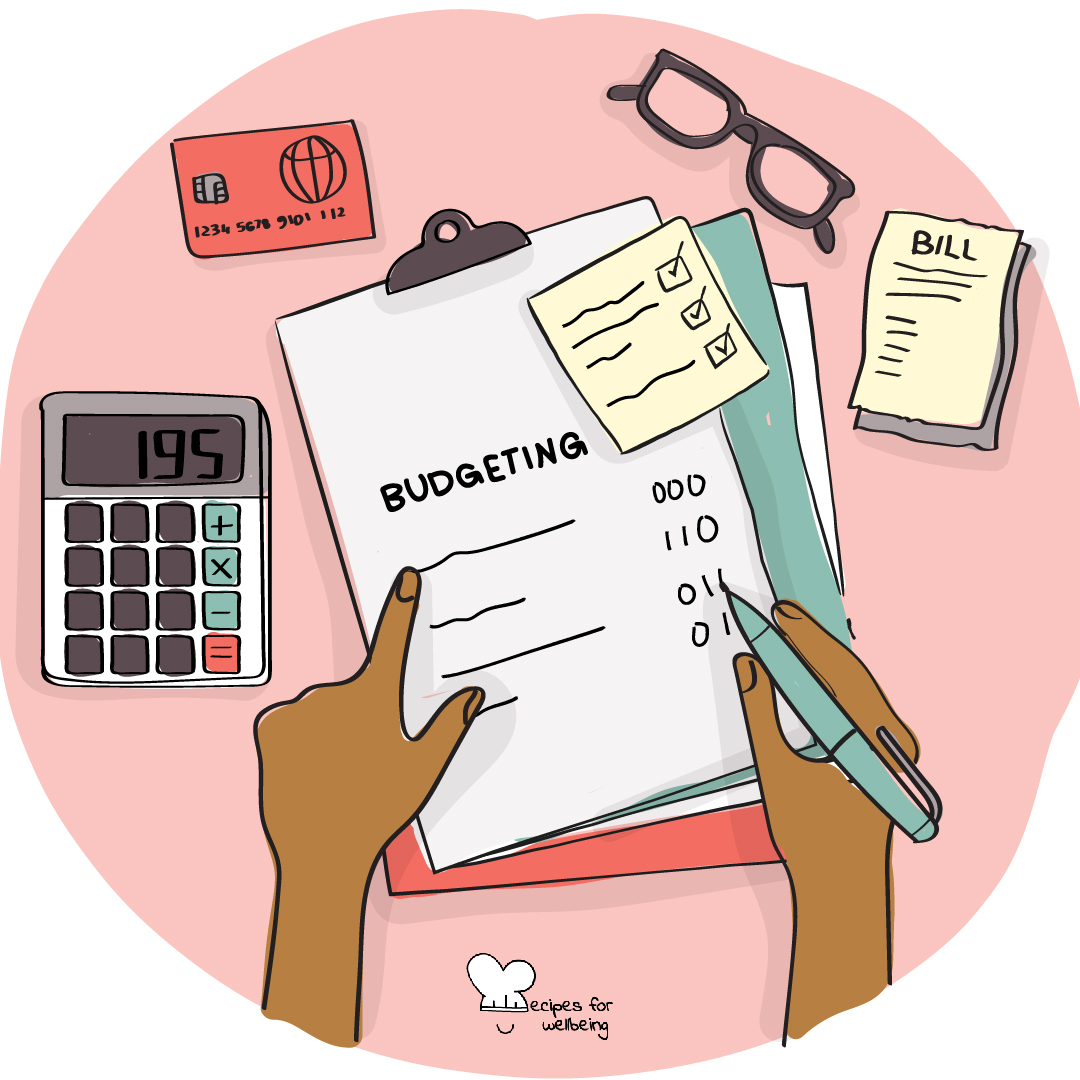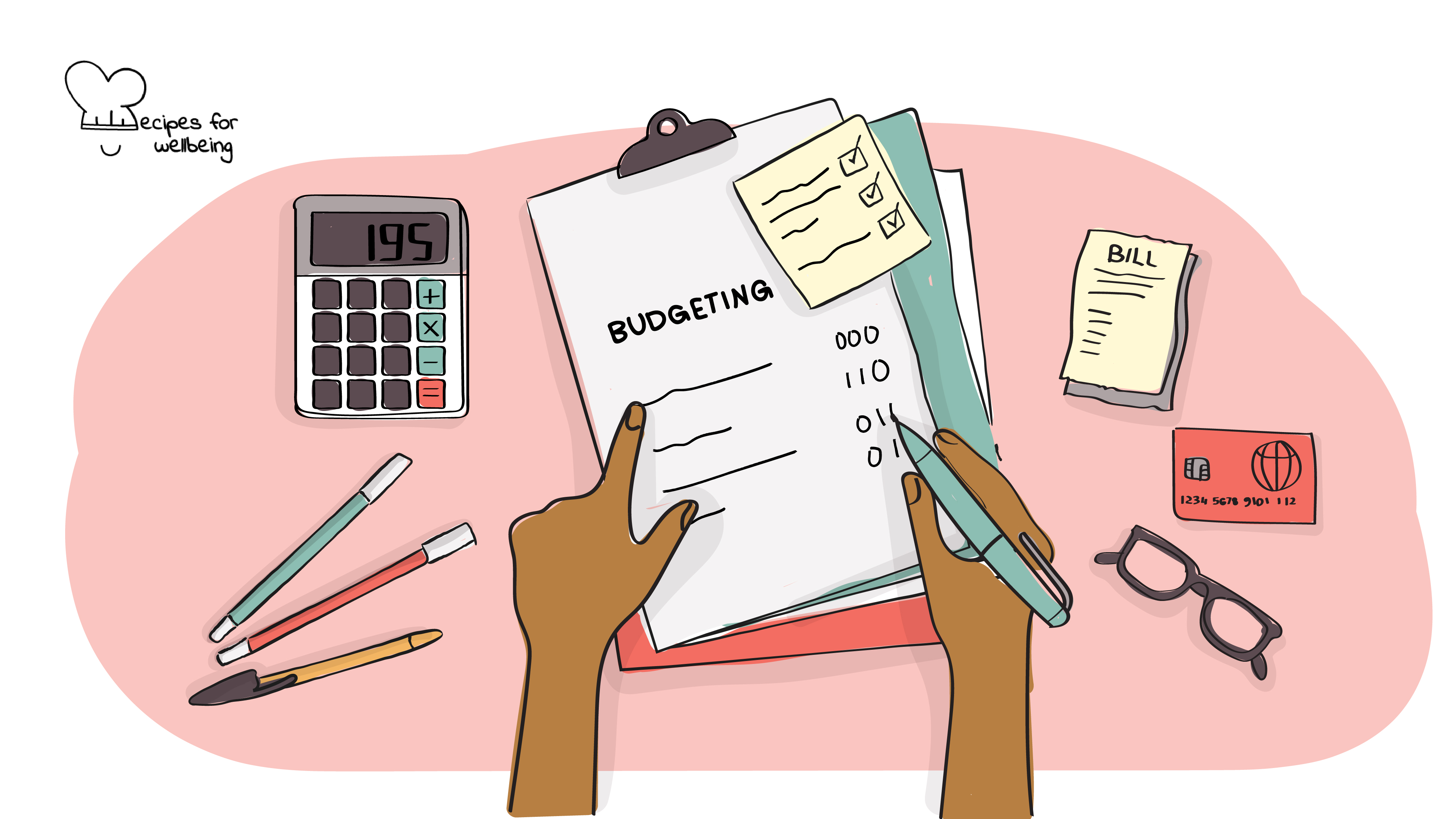
Tips for financial budgeting
Discipline is choosing between what you want now and what you want most. ―Abraham Lincoln
👥 Serves: 1 person
🎚 Difficulty: Medium
⏳ Total time: 61-120 minutes
🥣 Ingredients: Pen and paper, or your laptop/phone
🤓 Wholebeing Domains: Accomplishments, Positive Emotion
💪 Wholebeing Skills: Abundance, Contentment, Goal-setting, Planning

Tips for financial budgeting
📝 Description
A financial budget based on your personality.
A budget is important to create financial stability. By tracking expenses and earnings, a budget makes it easier to pay bills on time, build an emergency fund, and save for the future. When one is in control of finances, it results in decreased stress, anxiety, and worry.
There is no one-size-fits-all approach to budgeting – everyone prefers to track their expenses and earnings in different ways. Different spending ways match with different budgets. Finding a budget that works for your individual needs is a good approach as it is more likely to keep you motivated and on track!
This recipe is divided into three tracks, depending on your spending tendencies:
- If you are someone who prefers to save a lot of money, go to track 1.
- If you are someone who is a big spender, go to track 2.
- If you are someone who is brand new to budgeting, go to track 3.
This recipe has been created by our wellbeing content writer collaborator Marissa Del Mistro.
👣 Steps
Track 1 – Pay-yourself-first (2 hours)
A pay-yourself-first budget is a “reverse” budgeting strategy whereby you save a portion of your income, by treating your savings like a bill, then use the remainder of the income (after taxes) for expenses, followed by whatever else you wish to buy.
The pay-yourself-first budget is often considered quite an easy approach to budgeting, as there is no need to spend time tracking every single expense, instead the priority is on savings and expenses.
If your savings goal is to save 20% of your income, of which 10% is for retirement, 5% towards an emergency fund, and 5% towards a fun fund (e.g. a vacation), then the remaining 80% of your income can then be spent however you wish.
Sounds like it will work for you? Here are the steps to creating this budget:
Step 1: Create a Budget
- You’ll need a baseline for how much you can pay yourself. To do this, review your bank and credit card statements and add up your expenses. Expenses include rent, groceries, subscriptions, car/travel, water bills, heating bills. etc. Compare those totals to your income to see how much extra money you have in your budget.
- Where to create a budget? It’s completely up to you. There are mobile applications, Excel sheets, computer programs, or the classic pen and paper.
Step 2: Determine your saving goals
- After determining your leeway of finances each month, you must then decide what to do with your money. Can you manage to save 10%, 12%, or more?
- When you’re creating a pay-yourself-first budget, one of the first questions you may have is “How much should I pay myself?” Financial pros suggest at least 20% of your income each month. This won’t always be realistic, however, and that is absolutely fine. Be realistic with your spending to avoid any future issues. If you are at a point where 5% is realistic, great! Saving even a little bit is an incredible gift.
Step 3: Set up Automatic Transfers
- Automatic transfers will be lifesavers! For the 1 hour or so that they take to set up, you will save a ton of time and stress in the future. Set up your automatic transfers for the day (or the day after) you get paid to be swiftly taken into your one or more saving accounts and for bills. Speak to your landlord/bank to see if you can automate rent or mortgage payments too! This way, the temptation of spending this money is eliminated!
Step 4: Go about your monthly spending
- With this budget, you do not need to spend any time or effort tracking your daily/weekly spending, saving your time and mental energy. Of course, you will need to be aware that you are not overspending or that you end up with debts, but it’s nice to have financial freedom on how you wish to spend the rest of your paycheque.
Step 5: Adjust, when/if necessary
- If you get a new job or get increased pay, you can then adjust your spending and savings as needed. If you are finding you are struggling with putting, say 15% of income towards saving, you can easily change that to something more suitable such as 10%.
Benefits and drawbacks of the pay-your-self first budget:
Benefits:
- Low-maintenance budgeting
- Prioritises savings
- Automates your finances and budget
Drawbacks:
- If you are currently living paycheck-to-paycheck, this may be a hard budget.
- If you are not careful, as you are not tracking, it may lead to undisciplined spending.
Track 2 – The 50/20/30 budget (2 hours)
This is a great budget for people who struggle to keep up with their finances or struggle to resist spending on plenty of “wants” every month. It is also a great budget for people new to budgeting and those who are keen to watch their finances every month.
The 50/20/30 budget works by breaking up your income (after tax) into three categories: 50% of needs (think: expenses, bills, rent), 30% for wants (think: the new coffee table you’ve been eyeing), and 20% towards savings or debts.
Sound like the budget for you? Here are the steps:
Step 1: Create your budget
- To begin with, the 50/30/20 budget determines your after-tax income. If you have varied income or are a freelancer, do it based on your average. Once you have that number, split it into the allotted percentages to get each category’s maximum budget!
- Note that 50/30/20 is a starting point and may not be realistic to your situation – which is fine! Perhaps 60/30/10 is more realistic – do tweak it to your individual financial situation.
- It’s quite motivating to see how quickly the money you put towards savings can add up. For example, say you bring home €2,000 each month, you could put €400 towards your savings, which in one year is close to €5,000! Yay!
Step 2: Determine which category is what
- Using your last few months’ spending habits, determine what spending goes into which segment. If you are getting a bit lost in the numbers, look at an expense and ask, “Could I live without this?” Be honest with yourself to determine an accurate picture.
- A 50/30/20 rule spreadsheet is a good idea to keep you on track, especially if you’d prefer to have a more in-depth budget. Spreadsheet software such as Microsoft Excel, Google Sheets, and Apple Numbers all offer premade templates to simplify the process.
Step 3: Automate deposits
- Automatic transfers are the best! For the 1 hour or so that they take to set up, you will save a ton of time and stress in the future. Set up your automatic transfers for the day (or the day after) you get paid to be swiftly taken into your one or more saving accounts and for bills. Speak to your landlord/bank to see if you can automate rent or mortgage payments too! This way, the temptation of spending this money is eliminated!
Step 4: Tweak accordingly
- If this is your first time properly addressing your spending habits (well done!), you may wish to address some troubling areas – especially if you are prone to overspending. Are there ways you can adjust your lifestyle to stay your means? For example, did you take 10 Ubers to work a month, when you could have taken the bus? Can you change energy providers to save on your utility bills? Do you have a streaming service you can cancel or share with your roommates/family? Never judge yourself but think of your future – subtle adjustments can make a huge impact!
Benefits and drawbacks of the 50/30/20 budget:
Benefits:
- Low maintenance budgeting.
- Simple to follow.
- You understand what your money is doing every month.
- Help you to reduce things in life you can live without.
Drawbacks:
- It can be hard at first to determine where each spend fits.
- You may tweak the percentages based on your income levels/cost of living.
- 30% is a significant amount of money towards “wants”.
Track 3 – Zero-based budgeting (2 hours)
Zero-based budgeting is great for people brand new to tracking their expenses and it’s a very popular way of approaching finances. It is a budget which focuses on starting from 0, then adding in your monthly income, then each spend after that is all analysed and accounted for until you again reach 0! Of course, it’s pretty important to have some leeway in your account (even if it’s €100!) By the end of the month, the goal is that your income minus your expenditures equal zero.
Sounds good? Here are the steps:
Step 1: Create your budget
- Create your budget by including your income, your outgoings, and lists of expenses. The best way to do this is to consider your last one to three months of payments for an accurate depiction.
Step 2: Determine categories
- Create categories for “wants” and for “essentials.” Wants are things you can live without such as dinner with friends, new outfits, etc. whereas essentials are bills, mortgage/rent, groceries, car payments, etc.
- Categories can be named whatever you want – be creative – and can be done on whatever platform you prefer, whether that’s an app on your phone, computer, journal or just a pen and paper!
Step 3: Divvy up the funds
- After you’ve determined your various fund categories, take your available money, and put each dollar into your varied categories, until there is no money left (Not literally!).
- After you divide up the funds, you will either have a positive, green budget, which means that every dollar has its home, and you are not in the negative. If it is negative (you are spending more than you have) you should look through your spending habits carefully and see where you can cut down on things. This could look like switching phone providers, cutting down on subscriptions you don’t use much, and even trying a more budget-friendly grocery store.
Step 4: Tweak accordingly
- There are often little surprises in life that require additional spending, so you will likely need to remain flexible in the budgeting department. As you go through the week, track your daily expenses in your budget and if you need to switch things up in different categories to make things work, so be it! A zero-based budget is good for flexibility, so long you keep tracking it. Need €50 for a birthday gift? Cool, take it out of another category to cover it for the money! Did your energy bill cost a bit more than you thought? Take out the difference from your grocery or gas bill.
Benefits and drawbacks of the zero-based budget:
Benefits:
- Insightful on all of your expenses to allow you to deeply get where every dollar goes.
- Flexibility.
Drawbacks:
- Time-consuming inputting all of your spendings.
Step 4 – Just do it!
Ultimately, you can try various budgets until you find the one that works best for you and your lifestyle and current stage/situation. If you have tried and failed, try matching to one of the above budgets that work well with your personality!

